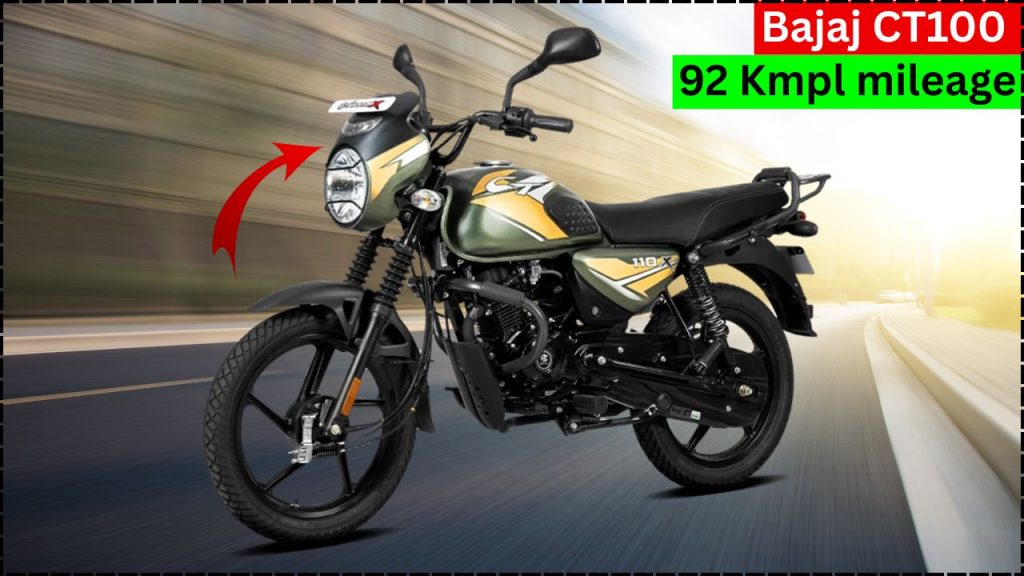
The Bajaj CT100 stands as one of India’s most significant motorcycles, not for groundbreaking technology or impressive performance figures, but for democratizing motorized mobility for millions of Indians. In a country where two-wheelers serve as the backbone of personal transportation, this modest motorcycle has carved a distinct identity by balancing affordability, reliability, and economy in a package that makes sense for everyday riders.
With an exceptional 92 Kmpl mileage figure, the CT100 continues to set the standard for fuel efficiency in the entry-level segment, making it an economical choice for budget-conscious consumers seeking dependable transportation.
Evolution of a Market Leader
The CT100’s story begins with Bajaj Auto’s transformation from a scooter manufacturer to a motorcycle company in the 1990s. Following successful collaborations with Kawasaki, Bajaj introduced the Boxer in 1997, targeting the value-focused commuter segment. The CT100, launched in 2004, evolved from this platform with further cost optimizations aimed specifically at rural and semi-urban markets.
After a brief hiatus, Bajaj reintroduced the CT100 in 2015 with significant updates. Since then, the motorcycle has received incremental improvements to meet changing emission norms while maintaining its core proposition of accessible mobility. Each update has carefully preserved the motorcycle’s fundamental characteristics—simplicity, affordability, and efficiency—while incorporating necessary regulatory compliance and modest feature enhancements.
This evolutionary approach reflects Bajaj’s deep understanding of its target market, where radical changes could alienate price-sensitive customers who value familiarity and proven reliability over novel features.
Practical Design That Stands the Test of Time
The CT100’s design epitomizes functional minimalism, with every element serving a practical purpose rather than aesthetic indulgence. The motorcycle features a straightforward silhouette with a simple fuel tank, flat seat, and basic side panels that have remained largely consistent throughout its production run.
From the front, conventional headlamps (upgraded to LED DRLs in recent versions) are flanked by simple turn indicators. The instrument cluster remains determinedly analog, with a basic speedometer, odometer, and essential warning lights presented in a clear, legible format that prioritizes functionality over style.
Color schemes have evolved modestly, with recent models offering more contemporary graphics and hues while maintaining an overall conservative approach that ages gracefully. Materials and finishes prioritize durability over premium feel, with robust plastics and straightforward painted surfaces designed to withstand years of use in challenging conditions.
This approach creates a motorcycle that may lack visual excitement but delivers the practicality and longevity that defines true value for its target market.
Engine Performance: Efficiency Without Compromise
The heart of the Bajaj CT100 is its 102cc, single-cylinder, air-cooled engine that produces approximately 7.9 horsepower and 8.1 Nm of torque. These modest figures belie the engine’s most important characteristics—exceptional reliability and remarkable fuel efficiency that consistently exceeds 70 kilometers per liter under ideal conditions, with marketing materials proudly highlighting the 92 Kmpl figure.
The engine architecture is deliberately simple, with a two-valve configuration and basic carburetion (though newer models have incorporated fuel injection to meet BS6 emission requirements). This simplicity contributes to both manufacturing affordability and ease of maintenance, critical considerations for owners in areas with limited access to sophisticated service facilities.
Power delivery is tuned for tractability rather than excitement, with a focus on low-end torque that facilitates load carrying and climbing inclines without frequent gear changes. The four-speed gearbox features widely spaced ratios that maximize versatility across varied riding conditions, allowing efficient operation between 60-70 km/h.
Perhaps the most remarkable achievement of the CT100’s powertrain is its longevity, with many examples exceeding 100,000 kilometers with basic maintenance. This durability transforms the motorcycle from a mere commodity into a long-term investment for many families.
Practical Engineering for Real-World Conditions
The CT100 utilizes a simple tubular frame that prioritizes strength and durability. The conventional design facilitates easy repairs with widely available parts that local mechanics throughout India can readily service.
Suspension duties are handled by telescopic front forks and twin rear shock absorbers with a basic dual-spring design. The tuning favors load-carrying capability over handling precision, with slightly firmer settings that prevent bottoming out when carrying a pillion or cargo.
Recent regulatory requirements have introduced a combined braking system (CBS) that distributes force between the front and rear when the rear brake is applied. This basic system improves safety without significantly increasing complexity or maintenance requirements.
The 17-inch spoke wheels offer excellent durability and ease of repair compared to alloy alternatives. The slim tires prioritize low rolling resistance for fuel efficiency while providing adequate grip on paved surfaces.
At approximately 115 kg, the CT100’s low weight makes it manageable for smaller riders and facilitates easy maneuvering at parking speeds—important considerations for first-time motorcycle owners.
Unmatched Economics of Ownership
The CT100’s defining characteristic is its compelling economics of ownership, which extends far beyond the initial purchase price. With a starting price that has consistently remained among the lowest in the Indian motorcycle market, it represents the entry point to motorized transportation for many first-time buyers.
For many owners, the exceptional fuel efficiency translates to weekly fuel costs that remain within tight budget constraints, making ongoing operation affordable even for those with limited income. Maintenance requirements are minimal, with service intervals typically set at 3,000-kilometer intervals.
Insurance costs benefit from the motorcycle’s low value and extensive safety record, while replacement parts remain affordable and widely available throughout India’s extensive spare parts network. The CT100’s exceptional reliability minimizes downtime—a critical factor for owners who depend on their motorcycle for daily livelihood.
A Vehicle of Economic Empowerment
The CT100’s impact extends far beyond Bajaj’s balance sheet. As one of India’s most affordable motorcycles, it has served as the first step into motorized transportation for countless families, significantly expanding their economic opportunities through increased mobility.
For many small business owners, delivery personnel, and service providers, the CT100 represents an essential business tool that enables livelihood. In rural India, where public transportation remains limited, it has connected villages to education, healthcare, and employment opportunities previously inaccessible without personal transportation.
The motorcycle’s influence on the competitive landscape has been equally significant, establishing a benchmark for value that other manufacturers must consider when developing entry-level offerings.
By offering a genuinely practical transportation solution at an accessible price point, Bajaj has created a product that delivers tangible improvement in quality of life—the ultimate measure of meaningful innovation.
Final Analysis: The Brilliance of Focused Design
The Bajaj CT100 represents a masterclass in focused product development, where understanding user needs takes precedence over technological showmanship or stylistic indulgence. By relentlessly prioritizing affordability, efficiency, reliability, and simplicity, Bajaj has created a motorcycle that delivers exceptional value throughout its operational life.
While it may lack the excitement of performance-oriented motorcycles or the technological sophistication of premium models, the CT100’s significance lies in its accessibility. By bringing motorized mobility within reach of millions, this humble motorcycle has enabled economic advancement and expanded opportunities throughout India.
As the automotive industry increasingly focuses on electrification and digital integration, the CT100 serves as a reminder that true innovation isn’t always about adding features or complexity. Sometimes, the most impactful product development comes from identifying what can be removed while still delivering the core benefits users truly need—a lesson perfectly embodied in this unpretentious yet transformative motorcycle.

Katherine Johnson is a passionate writer with a keen interest in storytelling, content creation, and creative expression. She enjoys exploring diverse topics and crafting engaging narratives that captivate readers.



